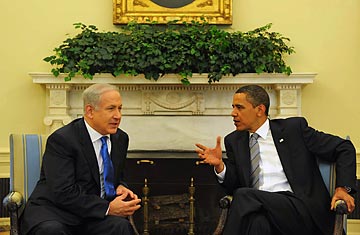
President Barack Obama, right, speaks with Israeli Prime Minister Benjamin Netanyahu
(2 of 2)
Cynicism over the two-state solution has grown, meanwhile, on both sides of the divide. Robert Malley, a negotiator on President Clinton's team at Camp David and who later gave advice to candidate Obama, has written a thoughtful assessment of the declining prospects for the two-state solution, along with Palestinian academic Hussein Agha, a longtime adviser to the Palestinian leadership. They point out that right now, the two-state concept has stronger support abroad than it does among Israelis and Palestinians, both of whom have always seen it, even in the best of times, as a bitter compromise that the balance of forces would compel them to accept.
Malley and Agha have some blunt advice for Obama. Achieving success "won't be done by repackaging the peace process of years past. It won't be done by strengthening those leaders viewed by their own people as at best weak, incompetent and feckless, at worst irresponsible, careless and reckless. It won't be done by perpetuating the bogus and unhelpful distinction between extremists and moderates, by isolating the former, reaching out to the latter, and ending up disconnected from the region's most relevant actors. It won't be done by trying to perform better what was performed before." The mantras of the two-state solution have lost their appeal through endless repetition, most passionately by foreigners often deemed by one side or the other to be hostile to their aspirations.
Rather than finessing what Bush and Clinton started, Obama may be forced to change the game, working with his partners in the Quartet established during the Bush era (including the E.U., the U.N. and Russia) and with the Arab League to forge an international consensus on the parameters for a fair solution to the conflict. That would require outlining the borders between two states (the formula for doing so, based on the 1967 borders, is already enshrined in existing documents such as the "Roadmap"), how to share Jerusalem, the fate of West Bank settlements and of Palestinian refugee families who lost land and homes inside Israel in 1948. In such a scenario, the focus of diplomacy would shift to coaxing, cajoling and nudging both sides toward implementing such a solution. (See pictures of George W. Bush in the Middle East.)
Obama on Monday didn't press Netanyahu to reverse his position on the two-state solution, but the Administration has begun pushing insistently for Israel to freeze settlement activity in the West Bank. That practical step toward the two-state destination will likely be the focus, for now, but the Administration is hoping to persuade Arab states to help by offering Israel fresh gestures of recognition in exchange for doing so. To that end, Obama will meet with Egypt's President, Hosni Mubarak, next week. And when the U.S. President meets Abbas, his focus will be both on relieving Israel's chokehold on Gaza and the West Bank, encouraging resolution of the crippling stalemate in Palestinian politics (which is as much of an obstacle to the two-state solution as Israel's settlement expansion) and on helping the Palestinians assume their responsibilities to create security conditions to enable Washington to demand more progress from Israel.
That there will be a peace process under Obama's aegis is beyond doubt right now, but it may look quite different from those that went before it.
